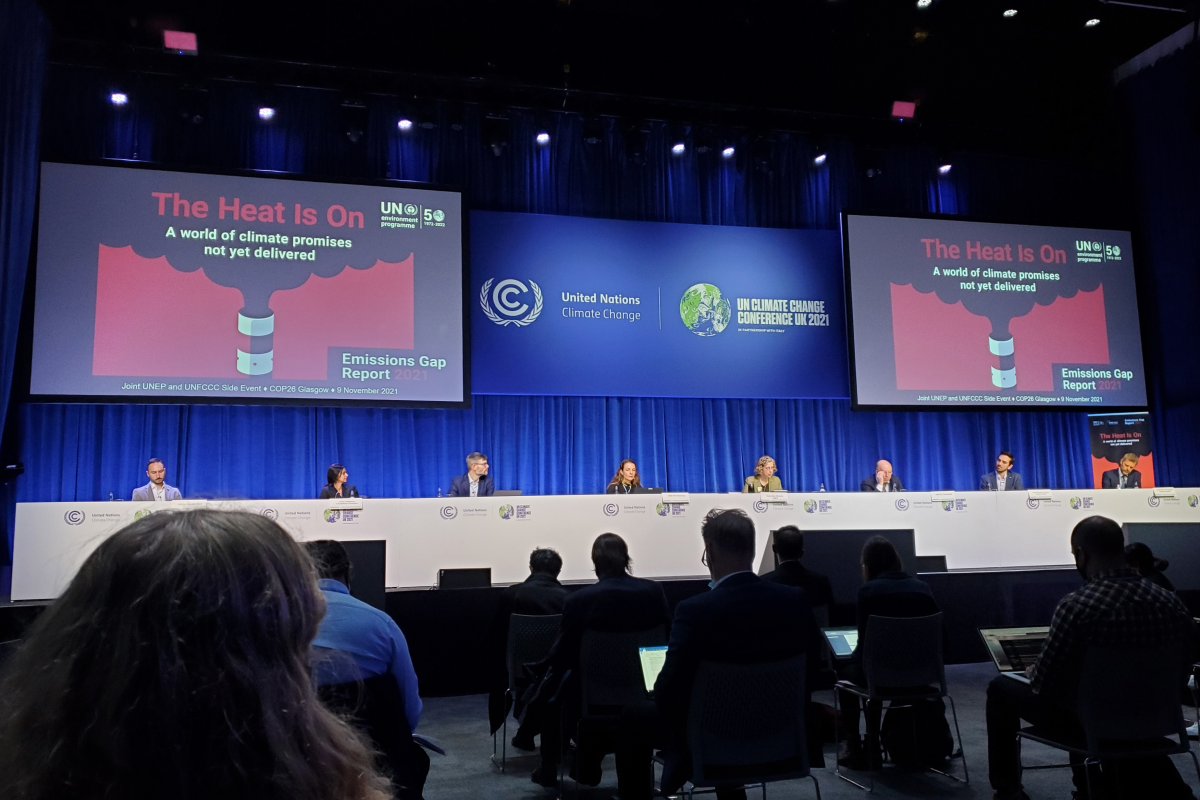Key takeaways from COP26
November 16, 2021
Share

The UN Climate Change Conference (COP26), held in Glasgow, Scotland, wrapped up last week, with some global agreements on reducing methane, stopping deforestation, and ending public financing for the fossil fuel sector. This year’s conference was seen as an opportunity to accelerate action on the goals agreed to at the 2015 Paris Agreement, including limiting the increase in the global average temperature to well below 2 degrees Celsius.
Ryan Riordan (Smith School of Business) reflects on the week he spent at the conference, which brought together over 25,000 participants, including world leaders, negotiators, and research experts to discuss how to reduce emissions and limit the rising temperature. For years, environmental scientists have warned of the severe consequences of rising global temperature — including flooding, wildfires, and crop failure.

Dr. Riordan, Director of Research at the Institute for Sustainable Finance (ISF) at the Smith School of Business, Queen’s University, attended the conference as head of the ISF delegation. The ISF is a collaborative hub that aims to align mainstream financial markets with Canada’s transition to a sustainable economy — which includes environmental sustainability, social sustainability, and economic prosperity. The ISF sent three delegates to COP26, after receiving accreditation earlier this year as a non-governmental organization to attend the conference.
Dr. Riordan shares his key takeaways from attending COP26.
- It is important that these meetings take place in-person.
“It was interesting to see the real business of translating UN rules into actual decisions and how all of the countries interact. That’s when it became clear to me that these meetings are super important. Doing that via Zoom isn’t feasible. If we want to get all of the countries together collectively, we have to do it all together in a room,” says Dr. Riordan, after attending translating technical requirements into financial capacity.
He also notes that the world’s focus and media attention on the conference puts a collective pressure and attention on governments.
“There is no other way to make meaningful progress without getting together,” says Dr. Riordan.
- The commitment to reduce methane was a win.
“It was almost half a day of focus on methane and how potent it is as a greenhouse gas, and how we need to tackle that. It was important progress that also probably wouldn’t have been made if we didn’t have a bunch of experts together at COP26 to make progress on that one topic,” says Dr. Riordan.
The Global Methane Pledge, signed by 105 countries including Canada, was one of the agreements that came out of COP26. Those who signed the pledge committed to reducing their overall methane emissions by 30 per cent by 2030, compared with 2020 levels.
“This was important because until now, methane has been excluded from the greenhouse gas emissions from the 2015 Paris Agreement.”
- The agreement to stop deforestation and start reforestation by 2030 was important.
“Stopping deforestation is an easy way to lower emissions, reduce the CO2 in the atmosphere and promote biodiversity,” says Dr. Riordan. “The commitment to stop deforestation by 2030 and start reforestation as of 2030 was important. It was a commitment by countries that currently have over 85 per cent of the forest cover.”
- There is more work that needs to be done on carbon taxes and the global carbon market.
“Wealthy countries need to take seriously the ability of carbon markets to reduce global emissions,” says Dr. Riordan.
The disagreements over components of Article 6 of the Paris Agreement, which would allow countries that exceed their emissions-reduction targets to sell credits to countries that are struggling to meet theirs, means this has not yet come into effect.
“In terms of Article 6,” says Dr. Riordan, “it doesn’t seem like we’re making progress.”
- The commitment to help developing countries tackle climate change needs to be met.
“I’m hoping we get the $100 billion a year for developing countries to help them tackle climate change,” says Dr. Riordan.
At the COP15 in 2009, there was a commitment from developed countries to deliver US$100 billion a year in support by 2020 to developing countries. A report prepared ahead of the COP26 finds that this goal was not met.
“These are countries that have arguably done the least to contribute to climate change and are being affected at least the same, but likely disproportionately more,” says Dr. Riordan. “Getting funding to them for mitigation and adaptation is super important.”

Coming out of COP26, Dr. Riordan says that in terms of sustainable finance what he would like to see is more funds being devoted directly to transition projects. This means more loans or investments in technologies and firms that are actually going to reduce CO2 emissions and not just commitments to do this in the future. He is optimistic that this will happen as it will be difficult for financial institutions to arrive at COP27 next year and make the same promises without delivering on promises from this year.
“The whole conference is about promises, so the question is really if they are actionable promises or clear commitments. I’d say quite a few of them were — deforestation and methane were certainly clear promises that will hopefully be turned into actions when the individual leaders return to their countries,” says Dr. Riordan. “Now the world will be watching to see if these promises result in tangible action.”
